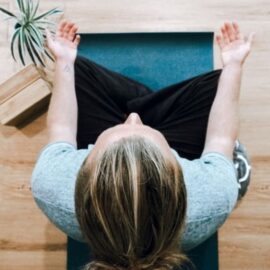

This article is an excerpt from the Shortform book guide to "Unbeatable Mind" by Mark Divine. Shortform has the world's best summaries and analyses of books you should be reading.
Like this article? Sign up for a free trial here.
What is Mark Divine’s box breathing technique? How does he use other meditation techniques to improve health and lower stress?
According to Mark Divine’s book Unbeatable Mind, to navigate his five levels of development, cultivate awareness, and apply that awareness to your own growth, you must train both your mind and body. To do this, Divine offers techniques for box breathing and meditation.
Read on for a guide to Mark Divine’s box breathing and meditation, according to Unbeatable Mind.
Divine’s Box Breathing & Meditation
In his book Unbeatable Mind, Mark Divine shares his box breathing technique along with a number of meditation and concentration techniques that he has learned or developed through studying such systems as Ashtanga yoga, Seido karate, and other eastern practices. According to him, you should practice these skills while keeping your mind focused on your purpose. This will give you the ability to turn your concentration on and off on command. These techniques include Mark Divine’s box breathing, developing a mantra, meditation, and journaling.
(Shortform note: In addition to helping with concentration and awareness, meditation can also help with mental health issues such as anxiety and panic attacks, as it helps shift your focus from sadness about the past or fear of the future to calmness in the present moment.)
Breathwork
Divine says that, while we’re all born knowing how to breathe correctly, that skill fades as we age, and by adulthood most people are only using one-third of their total lung capacity and taking three times as many breaths as they should. Breathwork, like Divine’s box breathing technique, is the most important tool in strengthening your mind.
(Shortform note: In addition to age differences, there are also gender disparities in lung function and capacity due to differences in rib structure and the muscles that allow for lung expansion. These differences may result from anatomical differences related to men’s and women’s reproductive organs and capabilities.)
Re-learning to breathe correctly strengthens your body’s physical breathing structures and immune system, and also improves your control over the flow of energy through your body. According to Divine, using focused breathwork to improve health is an integral part of many schools of yoga. It can help you manage stress and lengthen your life, and its spiritual benefits make it a great tool for navigating the five levels of personal development.
(Shortform note: Long Covid can drastically reduce lung capacity and function, as it’s a disease that attacks the organs—including the lungs. Deep breathing exercises can help strengthen the diaphragm and improve outcomes for people suffering from lung damage, though they should be avoided if they cause dizziness, chest pain, or other troubling effects.)
Divine offers a technique to retrain your body to breathe the right way:
- Breathing only through your nose, inhale deeply, pulling the air all the way down into your belly like you’re inflating it. Exhale completely, using your diaphragm to completely empty your lungs of air. Do this several times.
- On the following inhale, don’t stop when your belly is full, but use your diaphragm to widen your ribs and take in even more air. Then exhale completely, letting the ribcage relax and push out the air from the top down. Repeat several times.
- Finally, inhale as deeply as you possibly can, filling up the belly, the ribcage and the upper chest. Exhale completely from the top down again.
(Shortform note: Divine does not specify exactly how this process retrains your body to breathe, but we can infer that it strengthens the diaphragm and other muscles needed for respiration so that your breath will be stronger even when you’re not doing this exercise.)
Box Breathing
Mark Divine also describes a technique he refers to as box breathing. This involves four stages of breathing performed for five seconds each. Before you begin, empty the air from your lungs. Inhale for five seconds, hold it for five while keeping your body relaxed and avoiding clenching your muscles, exhale for five seconds, and then hold another five seconds before inhaling again. Add a five-second mantra that you repeat with each step to improve your results. Divine recommends using this technique for at least five minutes daily.
(Shortform note: Divine’s box breathing technique is a variation on yoga breathing, or pranayama. Pranayama encompasses a wide range of styles involving cycles of inhaling, holding the breath, and then exhaling in timed intervals, as well as more specific techniques like alternate nostril breathing.)
Mantra
In addition to Mark Divine’s box breathing technique, he advises developing a mantra to pair with your breathwork. A mantra is a short phrase that provides a positive or motivational boost to your mind. According to Divine, choosing an effective, positive, and catchy mantra will allow you to redirect your negative thoughts and replace them with positive thoughts that align with your needs and goals. You’ll use this mantra regularly in your practices, and eventually it’ll blend into your mental backdrop so you no longer have to consciously employ it.
(Shortform note: A mantra is a type of positive affirmation. In addition to conveying a positive idea as Divine says, your mantra will work better if it uses positive words as well, such as saying “I am strong” rather than “I am not weak” so that your focus is on the word strong and the word “weak” doesn’t slip into your subconscious.)
A mantra is essential for personal development but can also be very useful in motivating teams. As a leader, if you see your team struggling with motivation or feeling defeated, introduce a mantra that will reinvigorate them and refocus their attention on the task at hand.
(Shortform note: Research shows that repeating a statement or idea again and again makes us more likely to believe it’s true, even with simple ideas that we should know are false. Repeating a positive mantra can be particularly effective in teams involving children, as you’re teaching them positive ideas about themselves that they’ll internalize as truths.)
Meditation and Journaling
Finally, Divine offers two meditative practices to enhance your training in addition to box breathing and your mantra. Do these regularly to improve your concentration and overall health.
The methods he describes are insight meditation and contemplative meditation. These are techniques for analyzing what you believe to ensure that it’s correct and in line with your purpose. To practice these, you need to get rid of the assumption that you must be right and anyone who disagrees with you is wrong. Reflect on how other people view this belief in differing ways, deeply exploring each idea. You might begin to feel less attached to your belief and may want to change your views.
The difference between insight meditation and contemplative meditation is that the former involves focusing specifically on a belief you currently hold, while the latter involves focusing on a work of some kind that you would like to consider deeply, such as a book or a movie.
Divine says to follow both of these practices with a few minutes of journaling, writing down what your beliefs were beforehand and then noting how they have changed during the meditation.
| Meditation for Other Purposes Both of Divine’s meditation techniques are designed for concentrating on and analyzing what you believe, but there are many meditation practices available that focus on different results and activities. Mantra meditation is the practice of focusing on and repeating a mantra. This style helps you push out distractions, and the chanting of the mantra lets your breathing slip into a relaxing rhythm. Mantra meditation helps with focus, memory, energy, and mood. Spiritual meditation involves using self-reflection to connect with something higher or greater than the self. This can be a religious entity, but the practice isn’t specific to religion. It requires you to let go of negative feelings toward others and focus on helping them from a place of authenticity. Spiritual meditation can help with enriching your inner life, strengthening your faith, and seeking to help others. Present-moment meditation is a practice designed to center your awareness on the present, pushing out thoughts about the future or the past and tuning in to your senses—what you see, hear, and feel—in the moment. It can help with stress management and heart health, and it can also help you manage certain conditions like learning or mood disorders. Candle-gazing meditation involves focusing your eyes on an object—like the flame of a candle—in order to focus your mind on your own awareness. If you struggle to clear your mind in regular meditation, the visual stimulus of the candle can make it easier to clear out distracting thoughts. Candle-gazing meditation can help with sleep issues, concentration, and executive function, and may even improve eyesight. All of these practices can help you foster the type of awareness Divine describes—in addition to their other benefits—and aid you in your personal development and the building of your unbeatable mind. |

———End of Preview———
Like what you just read? Read the rest of the world's best book summary and analysis of Mark Divine's "Unbeatable Mind" at Shortform.
Here's what you'll find in our full Unbeatable Mind summary:
- Advice from a former Navy SEAL on how to maximize your success
- Tools for training your mind and developing mental toughness
- Why you should come up with a mantra for yourself






